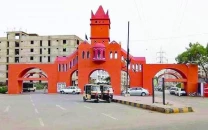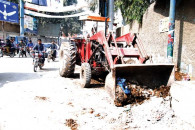SHC orders returning of housing scheme land to agri dept
The land, belonging to Horticulture Research Institute, has been used to study agri activities since 1904

PHOTO: REUTERS
In its detailed judgment, the Hyderabad circuit bench, comprising Justice Muhammad Shafi Siddiqui and Justice Muhammad Faisal Kamal Alam, gave the government two weeks to implement the order.
"If any structure is raised on the land in question, it should be demolished within two weeks and the entire land should be handed over to the department," states the order.
In 2010 and 2011, former president Asif Ali Zardari had ordered the provincial government to identify land for the SMBBT scheme, launched as a low-cost housing scheme.
A team of officials from the land utilisation (LU) department, along with the former Mirpurkhas commissioner and deputy commissioner selected 78.13 acres from the institute's 282 acres for the township project.
However, the move was challenged in the SHC, with the petitioners arguing that the research farm's land should not be used for residential purposes as it would affect ongoing research activities.
The institute was established in 1904 to conduct research on various crops, with the introduction of mango varieties as one of its achievements. According to the institute, 70 acres of the farm is dedicated for research on mangoes, 51 acres for vegetables, 24 for poultry and the remainder for other fruits and the office area.
The petitioner pointed out that efforts had also been made to occupy the land in the past, pointing to a 2009 SHC order that barred the conversion of the land for any other purpose.
"It is very surprising that despite the written comments of the Sindh government [that] research work has been continuing for last 70 years, the assistant advocate general stated that no research was in progress," the bench observed.
In 2011, the SMBBT facilitation committee identified land in 19 districts of Sindh for the project, including 200 acres in Hyderabad and 100 acres in Mirpurkahs. The LU department was of the view that agricultural research had no potential on the land and it should therefore be used for 'concrete structures.'
The institute submitted in court evidence to corroborate its assertion that the land had been in use for research, showing a list stating that annual horticultural events had been held there almost every year from 1965 to 2018.
The court noted that the Sindh chief minister and agriculture minister had attended the events between 2008 to 2012, but despite professing admiration of the institute's work, they had consented to Zardari's desire. It added that the Sindh agriculture department's attempt to save the land had been half-hearted.
The SHC further observed that ongoing rural urbanisation may be beneficial in the short term but would entail repercussions in the future.
Stating that agricultural land should not be spared for concrete structures when other options such as barren land were available, the judges said that legislation should be made preventing fertile land from being used for other purposes.
"We have often seen that for roads, bridges, gas or oil pipelines…most precious lands are acquired or intercepted…not realising that while doing so, we are not only destroying fertile land but also risking our future [with regard to food security]," read the order.
Published in The Express Tribune, May 1st, 2020.



















COMMENTS
Comments are moderated and generally will be posted if they are on-topic and not abusive.
For more information, please see our Comments FAQ